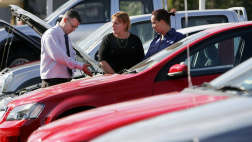The drama of Spyker - which bought Saab early last year - unfolded in Geneva when Saab chairman Victor Muller exposed the teetering financial condition of both car makers.
"One year ago Saab was in liquidation, had no cars in production, a supply chain in tatters and all its new models on hold," says Muller. "Now we have a milestone for the company. We have celebrated our 12 months of independence."
In fact, it's a double independence. One year ago General Motors sold Saab to Spyker for $400 million. Unfolding over the past few weeks, new owner Spyker found itself unable to swim in a sea of debt and has cut itself adrift. At the same time, it revalued Saab at $200 million - half of what it paid.
"Spyker needs cash," Muller says. "It needs euro 25 million (about $36 million) to keep going. "We can get that by issuing new stock in the company but that would dilute existing shareholders by 22 per cent.
"That is unjustified. The only solution was to split Spyker and Saab." Saab and its parent Spyker will now go on different roads with a change of the board of directors. They will, however, be linked. Muller, for example, is to remain chairman of both companies. But the divorce allows each to concentrate on their specific paths.
Saab is quickly out of the blocks running solo. To celebrate its single status, Muller says it will introduce a limited edition of 300 cars. "Next year, we will celebrate the second year of independence with the launch of another series of limited edition models.
"And we will keep this up, year after year, until infinity." Concurrently, Saab next month starts building its new 9-4X SUV in the US and plans to expand production of its 9-5 Sport Combi - a car Muller says "is extremely important to us in Northern Europe and especially Sweden".
"Seldom have we been able to introduce so many products," says Muller. "In 2012 we will have the new 9-3. New products will be based on flexible architectures and we will offer vehicles designed for drivers.
"Small displacement engines with turbocharging will become our cornerstone for the future for Saab." Powertrains for the 9-4X and 9-5 come from GM but the 9-3 gets a BMW turbo-petrol engine.
The platforms come from the Phoenix architecture that formed the basis for Saab's Phoenix show car at Geneva. This architecture for the 9-3 can be stretched for 9-5 but, says Muller, would be too expensive to be cut back to create a proposed 9-2 small car.
Saab employed designer Jason Castriota to style the Geneva show car, the Phoenix. The coupe is a metal-finished, distinctly aeronautical coupe that bristles with unusual lines.
Muller says its a concept "a pointer to the future" and while he doesn't see it as making the step to production, he believes key design elements will soon be used on production cars.
The concept uses a 147kW 1.6-litre turbo-petrol engine from BMW and has all-wheel drive using the engine for the front wheels and an electric motor for the rear.
Spyker, which makes the short wheelbase C8 - as a Spyder and Laviolette coupe - and its newer Aileron exotic sports cars, will become an asset of UK-based Coventry Prototype Panels (CPP).
CPP - which is owned by Russian investor Vladimir Antonov - has been making body panels for Spyker cars for about 10 years. It also makes panels for other manufacturers, including the multi-million dollar Aston Martin One-77.
Spyker spokesman Sander Van Dijk says it has 38 dealers and makes about 50 cars a year. "But we are ramping up production of Aileron and plan 90-100 a year from 2012," he says.





.jpg)
.jpg)
.jpg)

_0.jpg)



.jpg)
 (1).jpg)


.jpg)
.jpg)

_0.jpg)
.jpg)

.jpg)
.jpg)




